The Importance of the Hilya

Above: Our Blue Hilya
The calligraphic adornment and embellishment of narrations describing the Prophet’s ﷺ blessed person has historically been one of the most widespread forms of Arabic calligraphy and illumination. Famous all over the Dar al-Islam, such works of devotional art are known simply as “The Adornment”: the Hilya (الحلية) in Arabic and in Turkish, Ottoman, Persian, and Urdu as the Hilye-i Şerif / حليہِ شريف.
Hilye texts feature some of the most common narrations from companions of the Messenger of Allah brilliantly yet incompletely describe he who is complete ﷺ. One famous narration that is often calligraphically embellished for hilyes is that attributed to the Prophet’s ﷺ nephew, son-in-law, and confidant ‘Ali—may Allah ennoble his countenance:
On the authority of Ali Ibn Abi Talib, may God be pleased with him, when he described the Prophet, may God send peace and blessings upon him, he said, "He was not excessively tall nor overly short, but was of medium stature among the people. His hair was neither short and curly nor long and thin. He was a strong man, but not stout or fat. His face was entirely white and round, and he had intensely black eyes and long eyelashes. He was big in the shoulders and back. He was not hairy except on his chest, and he had hard hands and feet. When he walked, he pulled himself forward as though he were walking downhill, and when he turned, he turned his whole body. Between his shoulder blades was the seal of prophecy, for he is the Seal of the Prophets. He was the most generous of men in his heart, the most truthful of them in speech, the mildest of them in temper, and the noblest of them in descent. Anyone who saw him immediately felt awe, and anyone who partook of his knowledge loved him. The one who described him says he has never seen anyone like him, either before or after him. May God bless him and grant him peace. God, bless and grant peace to Muhammad, your servant, your Prophet and your messenger, the illiterate Prophet, and to his family and companions, and grant them peace."
The hilye is a curious artifact. Why put so much effort into beautifying words which describe a person which could presumably have been drawn or painted? Most analyses will chalk this up to the Shari’a’s discouragement of drawing figures, and there’s no doubt that this played a vital role in the development of calligraphy as an art form. But seeing things solely through a legal lens misses the deeper point: For Muslims, the Prophet Muhammad ﷺ represents the homo completus, what in Arabic is known as al-insan al-kamil. Because of the unfathomable reverence Muslims hold the Messenger of Allah ﷺ in for having reached the zenith of intellect, psyche, physicality, and spirituality, there was an inherent awareness that any attempt at visually depicting him would be deficient at best and denigrating at worst. But what they did have were the recorded words of those who knew him ﷺ intimately. And so they set about adorning those blessed words, words which went on to evoke meaning, love, and devotion deep in the souls of believers all over the world.
We are so found of the hilye, and the way it subtly yet ingeniously imprints the heart with the brand of our master and our beloved, the Final Messenger of Allah, Muhammad ﷺ. It is our honor to launch it as one of our inaugural pieces here at Silsila.
This text and translation is copyrighted by Silsila and cannot be shared without permission.
For an incredibly eloquent description of the Hilya and its meanings, read this essay by the renowned American calligrapher Mohamed Zakariya.





